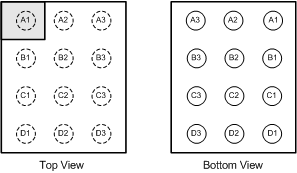SNVS793D November 2011 – May 2015 LM3269
PRODUCTION DATA.
- 1 Features
- 2 Applications
- 3 Description
- 4 Revision History
- 5 Pin Configuration and Functions
- 6 Specifications
- 7 Detailed Description
- 8 Application and Implementation
- 9 Power Supply Recommendations
- 10Layout
- 11Device and Documentation Support
- 12Mechanical, Packaging, and Orderable Information
5 Pin Configuration and Functions
YZR Package
12-Pin DSBGA
Top View

Pin Functions
| PIN | TYPE(1) | DESCRIPTION | |
|---|---|---|---|
| NUMBER | NAME | ||
| A1 | NC | — | Non Connection. Leave this pin floating; do not connect to PVIN or PGND. |
| A2 | NC | — | Non Connection. Leave this pin floating, do not connect to PVIN or PGND. |
| A3 | PVIN | P/I | Power MOSFET input and power current input pin. Optional low-pass filtering may help buck and buck-boost modes for radiated EMI and noise reduction. |
| B1 | VCON | A/I | Voltage Control analog input. VCON controls the output voltage in PWM and PFM modes. |
| B2 | EN | D/I | Enable pin. Pulling this pin higher than 1.2 V enables part to function. |
| B3 | PVIN | P/I | Power MOSFET input and power current input pin. Optional low-pass filtering may help buck and buck-boost modes for radiated EMI and noise reduction. |
| C1 | FB | A | Feedback input to inverting input of error amplifier. Connect output voltage directly to this node at load point. |
| C2 | SGND | G | Signal Ground for analog circuits and control circuitry. |
| C3 | SW1 | P/O | Switch pin for Internal Power Switches. Connect inductor between SW1 and SW2. |
| D1 | VOUT | O | Regulated output voltage of the LM3269. Connect this to a 4.7-µF ceramic output filter capacitor to GND. |
| D2 | SW2 | P/O | Switch pin for Internal Power Switches. Connect inductor between SW1 and SW2. |
| D3 | PGND | G | Power Ground for Power MOSFETs and gate drive circuitry. |
(1) A: Analog Pin, D: Digital Pin, G: Ground Pin, P: Power Pin, I: Input Pin, O: Output Pin.